Report on Organizational Behavior: Motivation Theories in Australia
VerifiedAdded on 2022/10/19
|12
|1875
|435
Report
AI Summary
This report delves into the realm of organizational behavior, specifically focusing on the theories of employee motivation and their practical applications within Australian organizations. It begins with an introduction to the field, emphasizing the importance of understanding human behavior within organizational structures to enhance employee performance, job satisfaction, and leadership effectiveness. The discussion section thoroughly examines key motivational theories, including Maslow's Hierarchy of Needs, the Hawthorne Effect, Equity Theory, and Hertzberg's Two-Factor Theory. Each theory is explained in detail, along with its relevance and perspective within the Australian organizational context. The report analyzes how these theories impact employee motivation, offering insights into how Australian businesses can leverage these concepts to improve workplace dynamics and achieve organizational goals. The conclusion summarizes the key findings, highlighting the significance of these motivational theories for fostering a productive and engaged workforce.

Running head: Organizational behavior
Organizational behavior
Organizational behavior
Paraphrase This Document
Need a fresh take? Get an instant paraphrase of this document with our AI Paraphraser

Organizational behavior 2
Table of Contents
Introduction......................................................................................................................................3
Discussion........................................................................................................................................3
Conclusion.......................................................................................................................................3
Reference.........................................................................................................................................3
Table of Contents
Introduction......................................................................................................................................3
Discussion........................................................................................................................................3
Conclusion.......................................................................................................................................3
Reference.........................................................................................................................................3
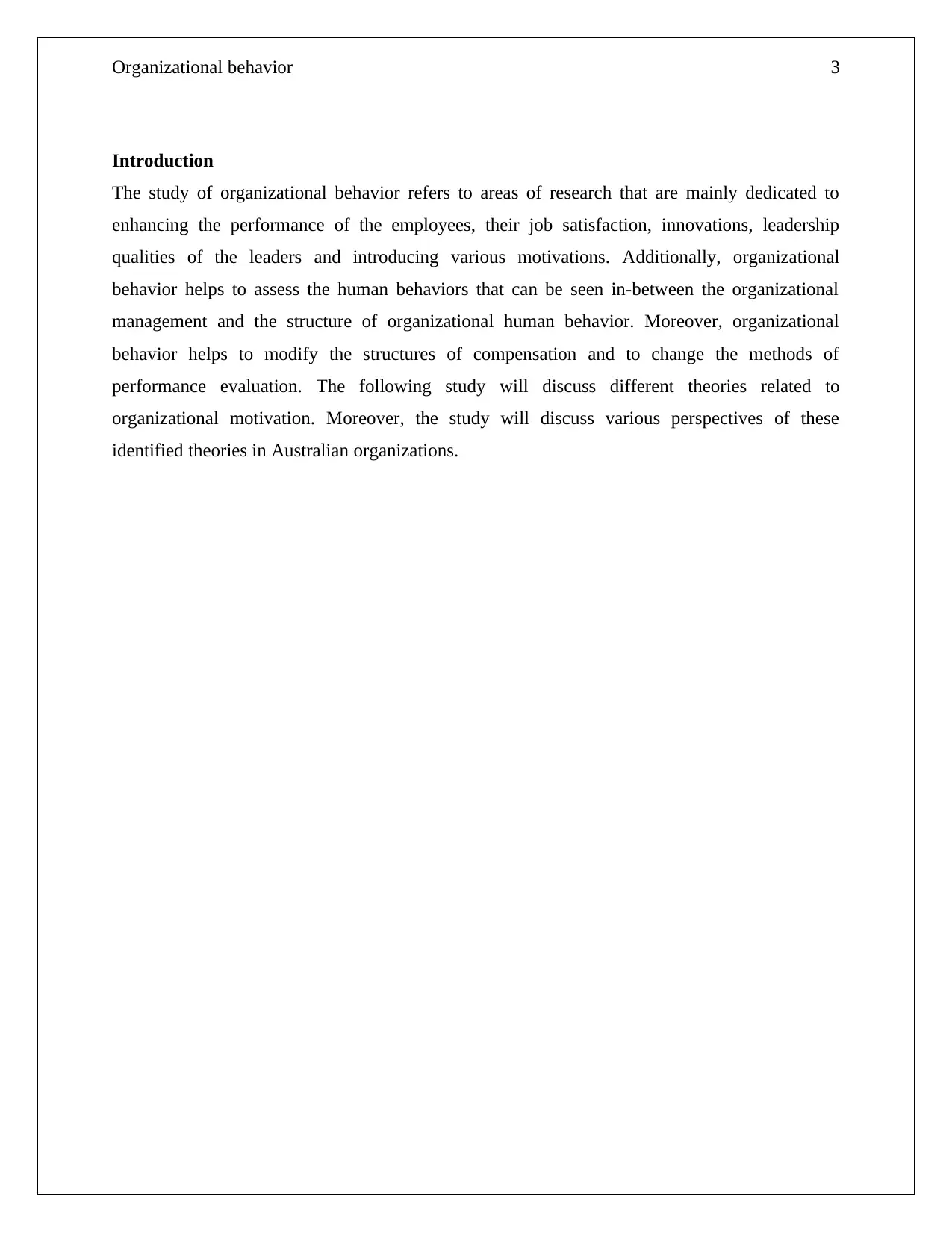
Organizational behavior 3
Introduction
The study of organizational behavior refers to areas of research that are mainly dedicated to
enhancing the performance of the employees, their job satisfaction, innovations, leadership
qualities of the leaders and introducing various motivations. Additionally, organizational
behavior helps to assess the human behaviors that can be seen in-between the organizational
management and the structure of organizational human behavior. Moreover, organizational
behavior helps to modify the structures of compensation and to change the methods of
performance evaluation. The following study will discuss different theories related to
organizational motivation. Moreover, the study will discuss various perspectives of these
identified theories in Australian organizations.
Introduction
The study of organizational behavior refers to areas of research that are mainly dedicated to
enhancing the performance of the employees, their job satisfaction, innovations, leadership
qualities of the leaders and introducing various motivations. Additionally, organizational
behavior helps to assess the human behaviors that can be seen in-between the organizational
management and the structure of organizational human behavior. Moreover, organizational
behavior helps to modify the structures of compensation and to change the methods of
performance evaluation. The following study will discuss different theories related to
organizational motivation. Moreover, the study will discuss various perspectives of these
identified theories in Australian organizations.
⊘ This is a preview!⊘
Do you want full access?
Subscribe today to unlock all pages.

Trusted by 1+ million students worldwide

Organizational behavior 4
Discussion
Organizational motivation can be recognized as one of the major factors that can effectively
inspire an employee or a group of employees to enhance their performance level in order to
achieve their goal. It is observed that controlling a business organization with several
unmotivated employees can effectively reduce the quality of work. Moreover, in order to
understand the organizational motivation theories and their perspectives on Australian business
organizations, the following theories are explained:
Organizational motivational theories and perspectives
Maslow's Hierarchy of Needs
The theory of Maslow’s hierarchy contains five certain levels of needs that effectively create an impact
on the motivation styles of an organization. According to Maslow, in order to motivate the employees,
Australian organizations need to identify the requirements of the staff to ensure that all of the employees
are satisfied with the company. However, the theory also explains that there is a need for food, shelter and
sleep among the employees. In addition to that safety is the second priority and belongings can be
referred to as the third most important need.
Figure 1: Maslow’s hierarchy pyramid of needs
Discussion
Organizational motivation can be recognized as one of the major factors that can effectively
inspire an employee or a group of employees to enhance their performance level in order to
achieve their goal. It is observed that controlling a business organization with several
unmotivated employees can effectively reduce the quality of work. Moreover, in order to
understand the organizational motivation theories and their perspectives on Australian business
organizations, the following theories are explained:
Organizational motivational theories and perspectives
Maslow's Hierarchy of Needs
The theory of Maslow’s hierarchy contains five certain levels of needs that effectively create an impact
on the motivation styles of an organization. According to Maslow, in order to motivate the employees,
Australian organizations need to identify the requirements of the staff to ensure that all of the employees
are satisfied with the company. However, the theory also explains that there is a need for food, shelter and
sleep among the employees. In addition to that safety is the second priority and belongings can be
referred to as the third most important need.
Figure 1: Maslow’s hierarchy pyramid of needs
Paraphrase This Document
Need a fresh take? Get an instant paraphrase of this document with our AI Paraphraser
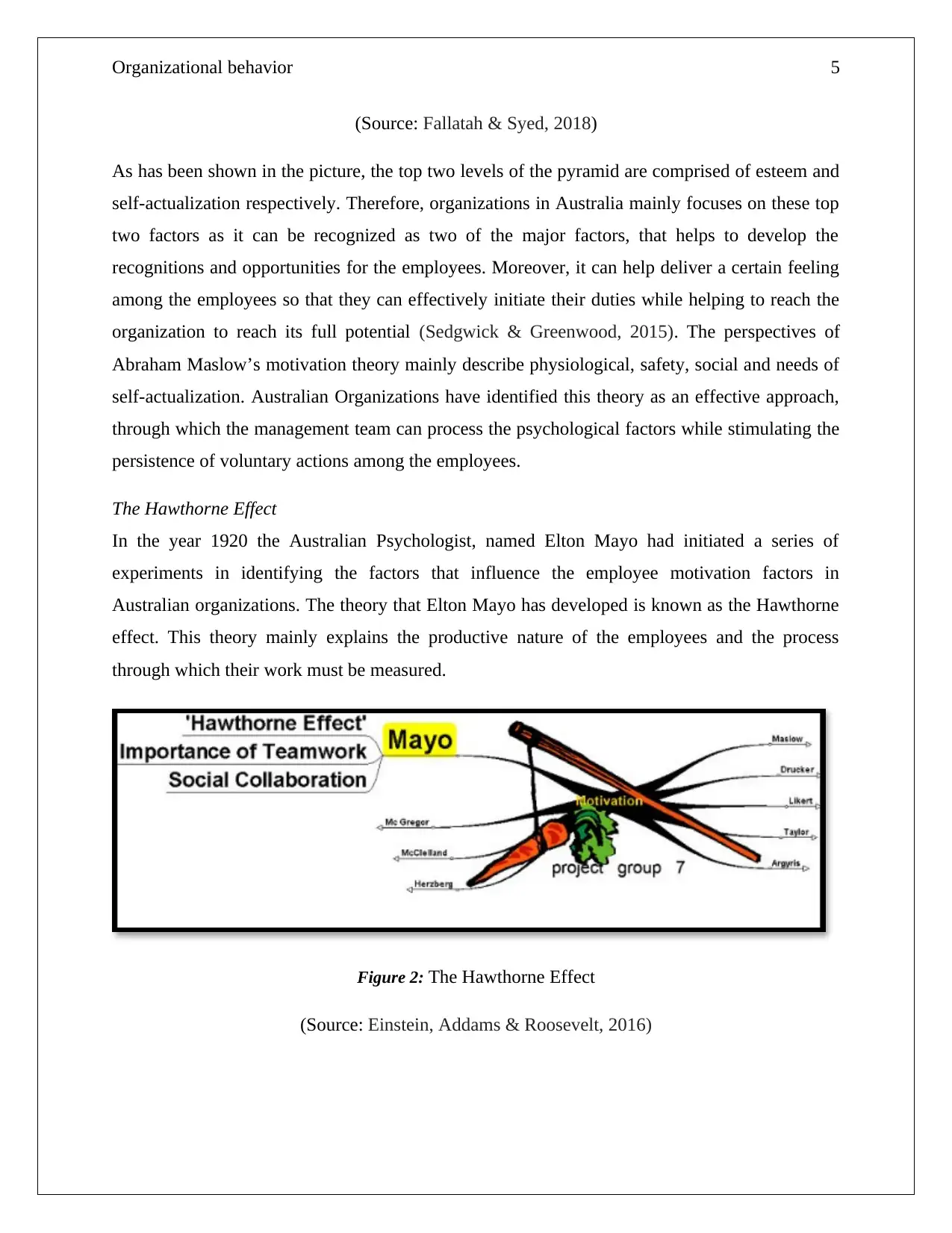
Organizational behavior 5
(Source: Fallatah & Syed, 2018)
As has been shown in the picture, the top two levels of the pyramid are comprised of esteem and
self-actualization respectively. Therefore, organizations in Australia mainly focuses on these top
two factors as it can be recognized as two of the major factors, that helps to develop the
recognitions and opportunities for the employees. Moreover, it can help deliver a certain feeling
among the employees so that they can effectively initiate their duties while helping to reach the
organization to reach its full potential (Sedgwick & Greenwood, 2015). The perspectives of
Abraham Maslow’s motivation theory mainly describe physiological, safety, social and needs of
self-actualization. Australian Organizations have identified this theory as an effective approach,
through which the management team can process the psychological factors while stimulating the
persistence of voluntary actions among the employees.
The Hawthorne Effect
In the year 1920 the Australian Psychologist, named Elton Mayo had initiated a series of
experiments in identifying the factors that influence the employee motivation factors in
Australian organizations. The theory that Elton Mayo has developed is known as the Hawthorne
effect. This theory mainly explains the productive nature of the employees and the process
through which their work must be measured.
Figure 2: The Hawthorne Effect
(Source: Einstein, Addams & Roosevelt, 2016)
(Source: Fallatah & Syed, 2018)
As has been shown in the picture, the top two levels of the pyramid are comprised of esteem and
self-actualization respectively. Therefore, organizations in Australia mainly focuses on these top
two factors as it can be recognized as two of the major factors, that helps to develop the
recognitions and opportunities for the employees. Moreover, it can help deliver a certain feeling
among the employees so that they can effectively initiate their duties while helping to reach the
organization to reach its full potential (Sedgwick & Greenwood, 2015). The perspectives of
Abraham Maslow’s motivation theory mainly describe physiological, safety, social and needs of
self-actualization. Australian Organizations have identified this theory as an effective approach,
through which the management team can process the psychological factors while stimulating the
persistence of voluntary actions among the employees.
The Hawthorne Effect
In the year 1920 the Australian Psychologist, named Elton Mayo had initiated a series of
experiments in identifying the factors that influence the employee motivation factors in
Australian organizations. The theory that Elton Mayo has developed is known as the Hawthorne
effect. This theory mainly explains the productive nature of the employees and the process
through which their work must be measured.
Figure 2: The Hawthorne Effect
(Source: Einstein, Addams & Roosevelt, 2016)
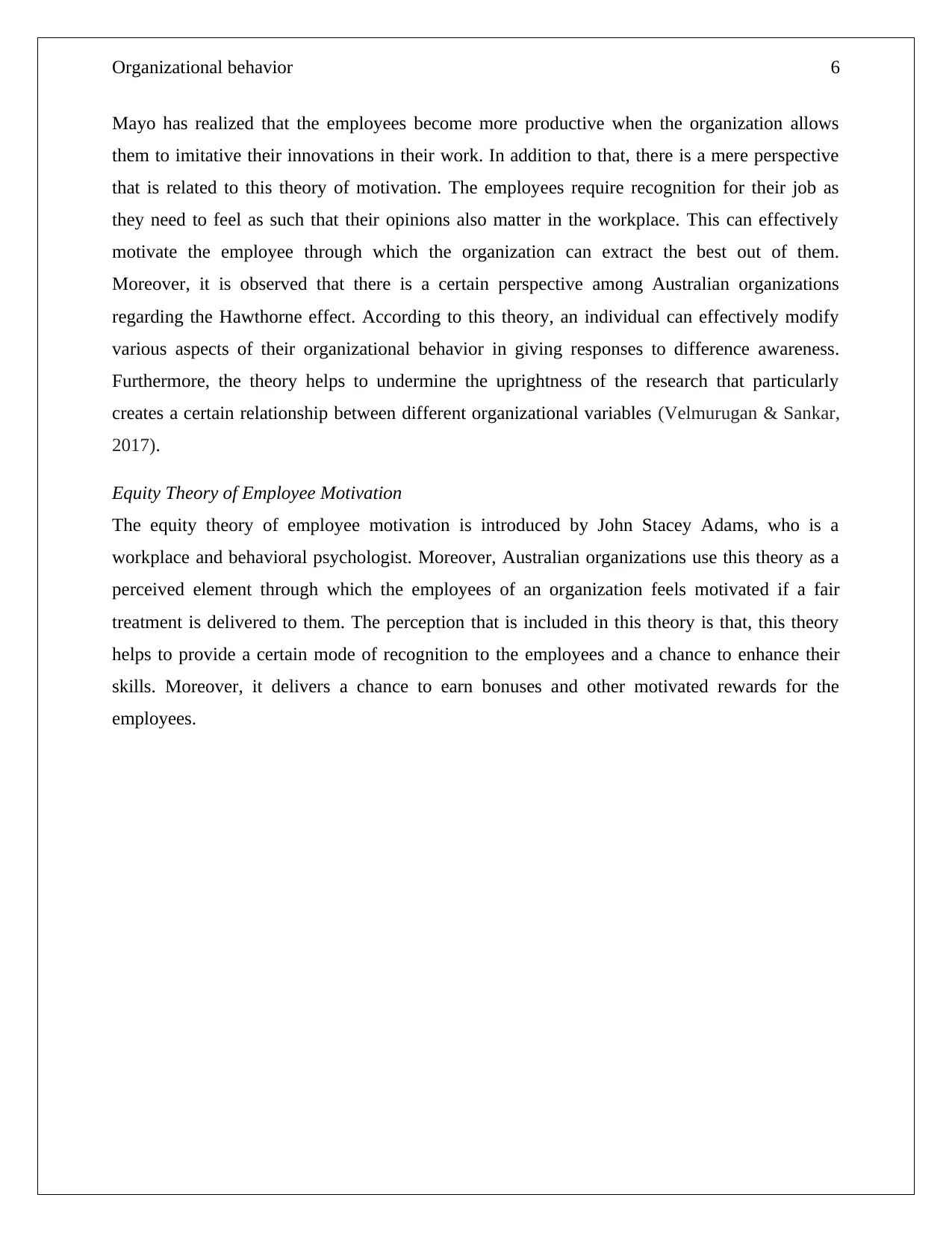
Organizational behavior 6
Mayo has realized that the employees become more productive when the organization allows
them to imitative their innovations in their work. In addition to that, there is a mere perspective
that is related to this theory of motivation. The employees require recognition for their job as
they need to feel as such that their opinions also matter in the workplace. This can effectively
motivate the employee through which the organization can extract the best out of them.
Moreover, it is observed that there is a certain perspective among Australian organizations
regarding the Hawthorne effect. According to this theory, an individual can effectively modify
various aspects of their organizational behavior in giving responses to difference awareness.
Furthermore, the theory helps to undermine the uprightness of the research that particularly
creates a certain relationship between different organizational variables (Velmurugan & Sankar,
2017).
Equity Theory of Employee Motivation
The equity theory of employee motivation is introduced by John Stacey Adams, who is a
workplace and behavioral psychologist. Moreover, Australian organizations use this theory as a
perceived element through which the employees of an organization feels motivated if a fair
treatment is delivered to them. The perception that is included in this theory is that, this theory
helps to provide a certain mode of recognition to the employees and a chance to enhance their
skills. Moreover, it delivers a chance to earn bonuses and other motivated rewards for the
employees.
Mayo has realized that the employees become more productive when the organization allows
them to imitative their innovations in their work. In addition to that, there is a mere perspective
that is related to this theory of motivation. The employees require recognition for their job as
they need to feel as such that their opinions also matter in the workplace. This can effectively
motivate the employee through which the organization can extract the best out of them.
Moreover, it is observed that there is a certain perspective among Australian organizations
regarding the Hawthorne effect. According to this theory, an individual can effectively modify
various aspects of their organizational behavior in giving responses to difference awareness.
Furthermore, the theory helps to undermine the uprightness of the research that particularly
creates a certain relationship between different organizational variables (Velmurugan & Sankar,
2017).
Equity Theory of Employee Motivation
The equity theory of employee motivation is introduced by John Stacey Adams, who is a
workplace and behavioral psychologist. Moreover, Australian organizations use this theory as a
perceived element through which the employees of an organization feels motivated if a fair
treatment is delivered to them. The perception that is included in this theory is that, this theory
helps to provide a certain mode of recognition to the employees and a chance to enhance their
skills. Moreover, it delivers a chance to earn bonuses and other motivated rewards for the
employees.
⊘ This is a preview!⊘
Do you want full access?
Subscribe today to unlock all pages.

Trusted by 1+ million students worldwide
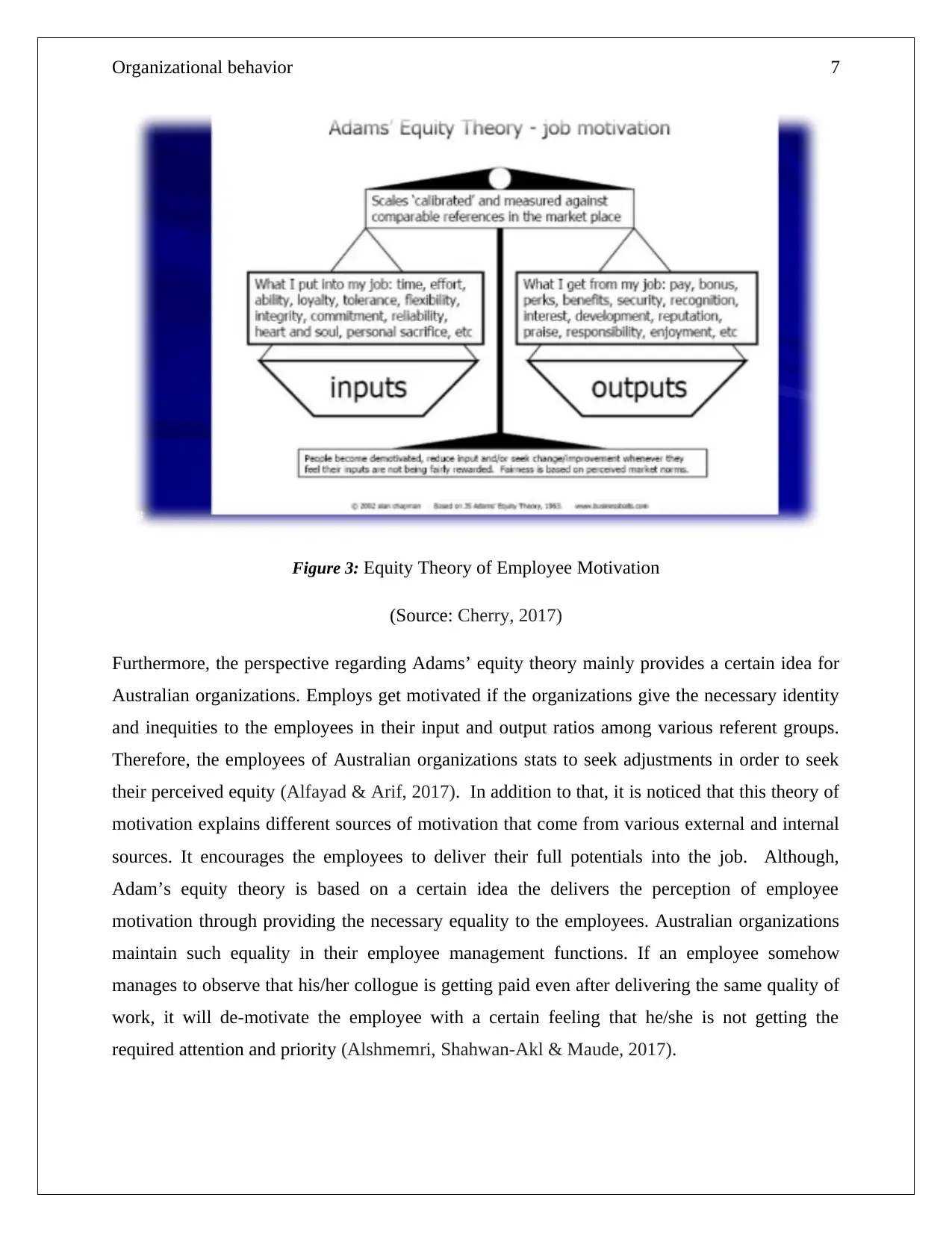
Organizational behavior 7
Figure 3: Equity Theory of Employee Motivation
(Source: Cherry, 2017)
Furthermore, the perspective regarding Adams’ equity theory mainly provides a certain idea for
Australian organizations. Employs get motivated if the organizations give the necessary identity
and inequities to the employees in their input and output ratios among various referent groups.
Therefore, the employees of Australian organizations stats to seek adjustments in order to seek
their perceived equity (Alfayad & Arif, 2017). In addition to that, it is noticed that this theory of
motivation explains different sources of motivation that come from various external and internal
sources. It encourages the employees to deliver their full potentials into the job. Although,
Adam’s equity theory is based on a certain idea the delivers the perception of employee
motivation through providing the necessary equality to the employees. Australian organizations
maintain such equality in their employee management functions. If an employee somehow
manages to observe that his/her collogue is getting paid even after delivering the same quality of
work, it will de-motivate the employee with a certain feeling that he/she is not getting the
required attention and priority (Alshmemri, Shahwan-Akl & Maude, 2017).
Figure 3: Equity Theory of Employee Motivation
(Source: Cherry, 2017)
Furthermore, the perspective regarding Adams’ equity theory mainly provides a certain idea for
Australian organizations. Employs get motivated if the organizations give the necessary identity
and inequities to the employees in their input and output ratios among various referent groups.
Therefore, the employees of Australian organizations stats to seek adjustments in order to seek
their perceived equity (Alfayad & Arif, 2017). In addition to that, it is noticed that this theory of
motivation explains different sources of motivation that come from various external and internal
sources. It encourages the employees to deliver their full potentials into the job. Although,
Adam’s equity theory is based on a certain idea the delivers the perception of employee
motivation through providing the necessary equality to the employees. Australian organizations
maintain such equality in their employee management functions. If an employee somehow
manages to observe that his/her collogue is getting paid even after delivering the same quality of
work, it will de-motivate the employee with a certain feeling that he/she is not getting the
required attention and priority (Alshmemri, Shahwan-Akl & Maude, 2017).
Paraphrase This Document
Need a fresh take? Get an instant paraphrase of this document with our AI Paraphraser
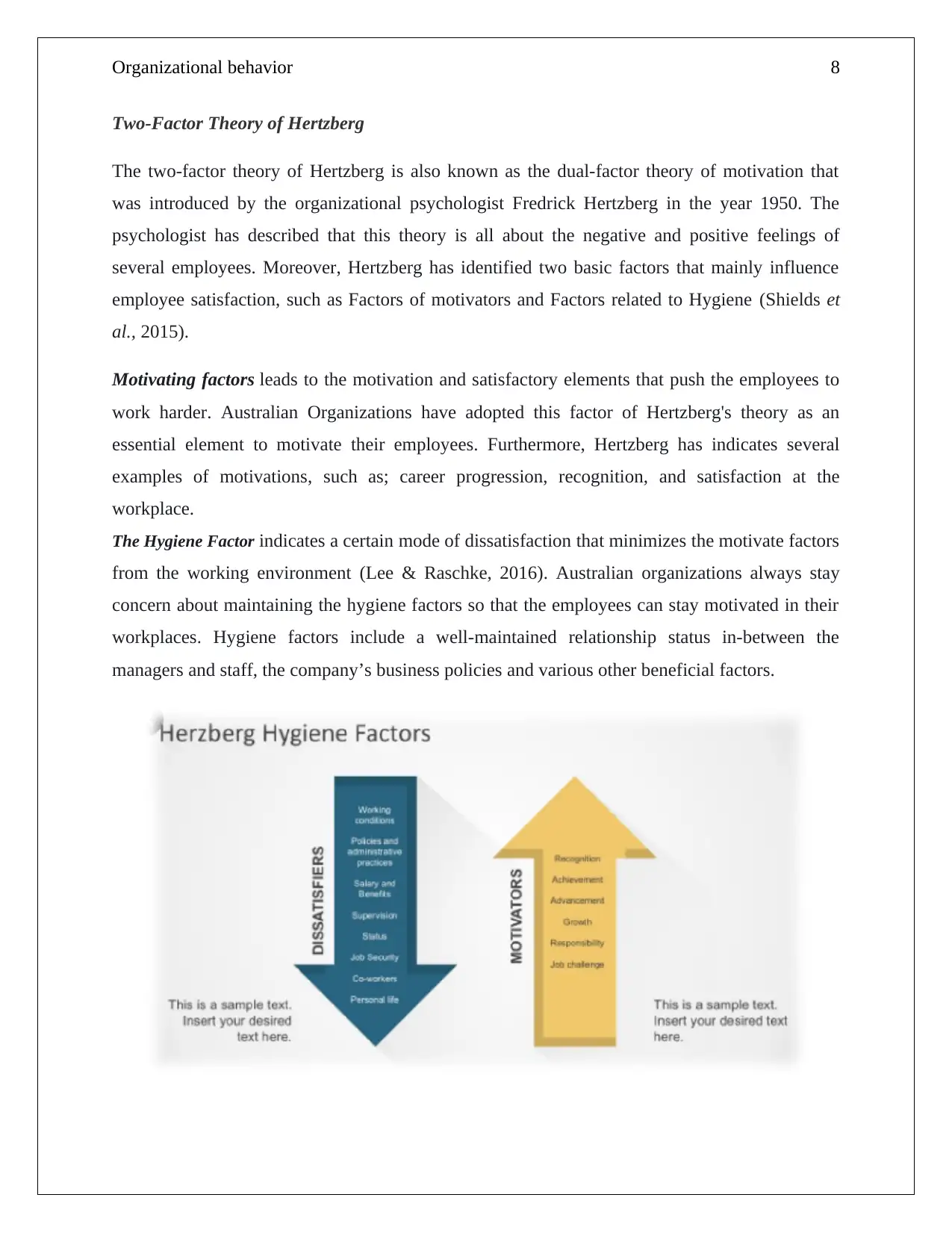
Organizational behavior 8
Two-Factor Theory of Hertzberg
The two-factor theory of Hertzberg is also known as the dual-factor theory of motivation that
was introduced by the organizational psychologist Fredrick Hertzberg in the year 1950. The
psychologist has described that this theory is all about the negative and positive feelings of
several employees. Moreover, Hertzberg has identified two basic factors that mainly influence
employee satisfaction, such as Factors of motivators and Factors related to Hygiene (Shields et
al., 2015).
Motivating factors leads to the motivation and satisfactory elements that push the employees to
work harder. Australian Organizations have adopted this factor of Hertzberg's theory as an
essential element to motivate their employees. Furthermore, Hertzberg has indicates several
examples of motivations, such as; career progression, recognition, and satisfaction at the
workplace.
The Hygiene Factor indicates a certain mode of dissatisfaction that minimizes the motivate factors
from the working environment (Lee & Raschke, 2016). Australian organizations always stay
concern about maintaining the hygiene factors so that the employees can stay motivated in their
workplaces. Hygiene factors include a well-maintained relationship status in-between the
managers and staff, the company’s business policies and various other beneficial factors.
Two-Factor Theory of Hertzberg
The two-factor theory of Hertzberg is also known as the dual-factor theory of motivation that
was introduced by the organizational psychologist Fredrick Hertzberg in the year 1950. The
psychologist has described that this theory is all about the negative and positive feelings of
several employees. Moreover, Hertzberg has identified two basic factors that mainly influence
employee satisfaction, such as Factors of motivators and Factors related to Hygiene (Shields et
al., 2015).
Motivating factors leads to the motivation and satisfactory elements that push the employees to
work harder. Australian Organizations have adopted this factor of Hertzberg's theory as an
essential element to motivate their employees. Furthermore, Hertzberg has indicates several
examples of motivations, such as; career progression, recognition, and satisfaction at the
workplace.
The Hygiene Factor indicates a certain mode of dissatisfaction that minimizes the motivate factors
from the working environment (Lee & Raschke, 2016). Australian organizations always stay
concern about maintaining the hygiene factors so that the employees can stay motivated in their
workplaces. Hygiene factors include a well-maintained relationship status in-between the
managers and staff, the company’s business policies and various other beneficial factors.

Organizational behavior 9
Figure 4: Two-Factor Theory of Hertzberg
(Source: Robertson, 2016)
The perception regarding this theory that is followed in the Australian organization is that it
increases employee motivation, satisfaction and helps to determine the absence of the above-
mentioned factors that causes dissatisfaction to the employees. In addition to that, another
perception that is widely recognized among Australian organizations is that the hygiene factors
always do not necessarily cause dissatisfaction as the basic requirement s are needed to delivered
first to the employees (Lăzăroiu, 2015).
Figure 4: Two-Factor Theory of Hertzberg
(Source: Robertson, 2016)
The perception regarding this theory that is followed in the Australian organization is that it
increases employee motivation, satisfaction and helps to determine the absence of the above-
mentioned factors that causes dissatisfaction to the employees. In addition to that, another
perception that is widely recognized among Australian organizations is that the hygiene factors
always do not necessarily cause dissatisfaction as the basic requirement s are needed to delivered
first to the employees (Lăzăroiu, 2015).
⊘ This is a preview!⊘
Do you want full access?
Subscribe today to unlock all pages.

Trusted by 1+ million students worldwide
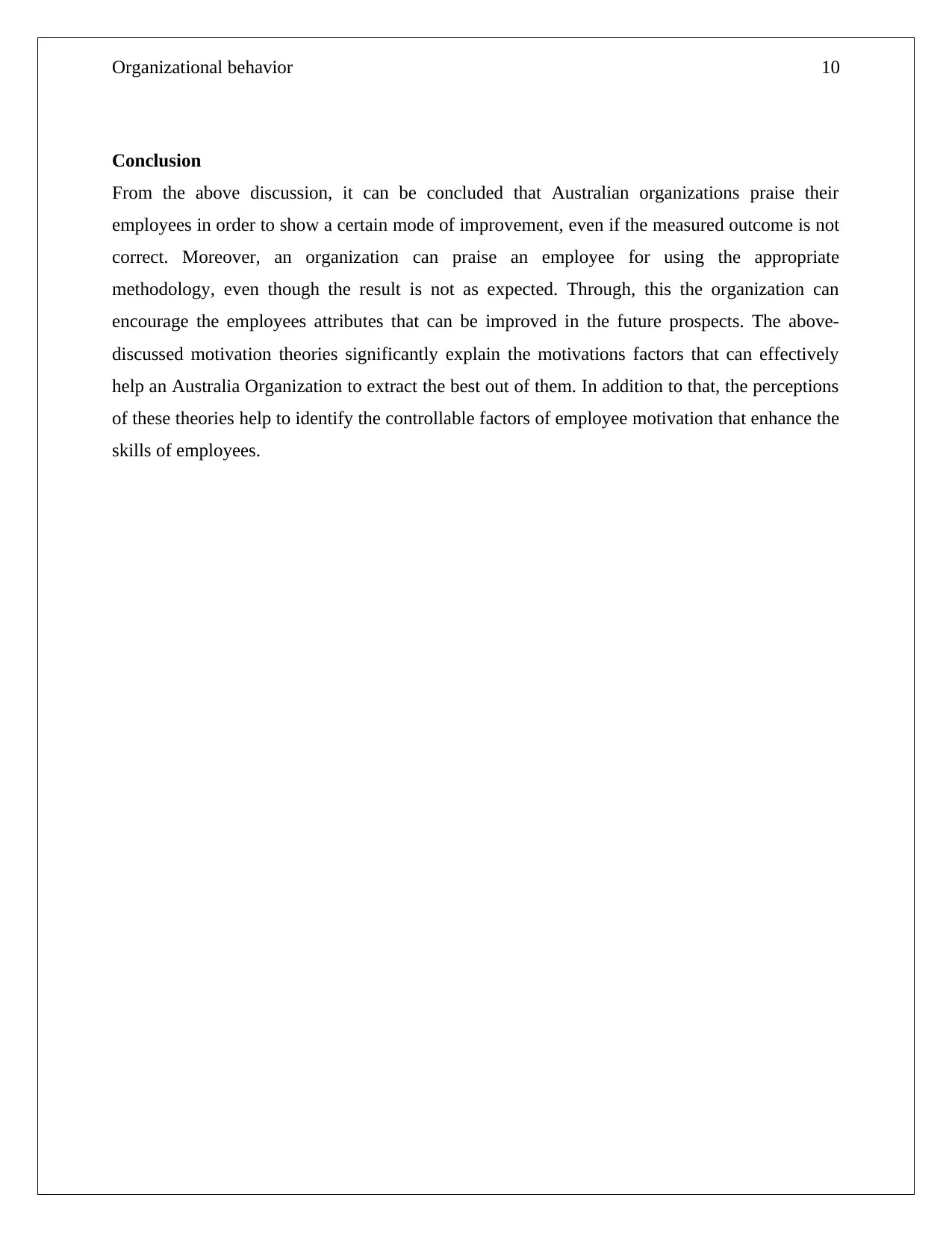
Organizational behavior 10
Conclusion
From the above discussion, it can be concluded that Australian organizations praise their
employees in order to show a certain mode of improvement, even if the measured outcome is not
correct. Moreover, an organization can praise an employee for using the appropriate
methodology, even though the result is not as expected. Through, this the organization can
encourage the employees attributes that can be improved in the future prospects. The above-
discussed motivation theories significantly explain the motivations factors that can effectively
help an Australia Organization to extract the best out of them. In addition to that, the perceptions
of these theories help to identify the controllable factors of employee motivation that enhance the
skills of employees.
Conclusion
From the above discussion, it can be concluded that Australian organizations praise their
employees in order to show a certain mode of improvement, even if the measured outcome is not
correct. Moreover, an organization can praise an employee for using the appropriate
methodology, even though the result is not as expected. Through, this the organization can
encourage the employees attributes that can be improved in the future prospects. The above-
discussed motivation theories significantly explain the motivations factors that can effectively
help an Australia Organization to extract the best out of them. In addition to that, the perceptions
of these theories help to identify the controllable factors of employee motivation that enhance the
skills of employees.
Paraphrase This Document
Need a fresh take? Get an instant paraphrase of this document with our AI Paraphraser
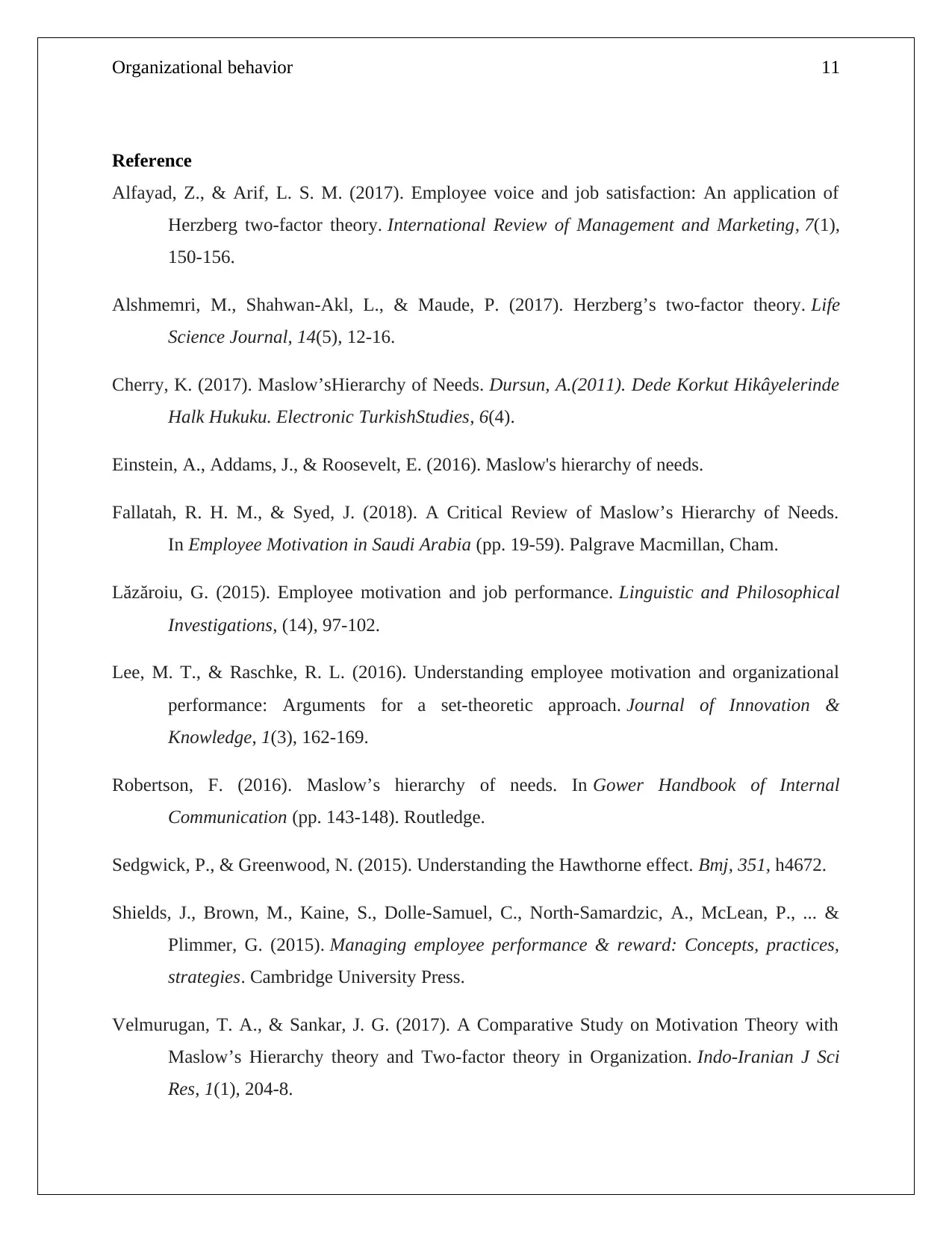
Organizational behavior 11
Reference
Alfayad, Z., & Arif, L. S. M. (2017). Employee voice and job satisfaction: An application of
Herzberg two-factor theory. International Review of Management and Marketing, 7(1),
150-156.
Alshmemri, M., Shahwan-Akl, L., & Maude, P. (2017). Herzberg’s two-factor theory. Life
Science Journal, 14(5), 12-16.
Cherry, K. (2017). Maslow’sHierarchy of Needs. Dursun, A.(2011). Dede Korkut Hikâyelerinde
Halk Hukuku. Electronic TurkishStudies, 6(4).
Einstein, A., Addams, J., & Roosevelt, E. (2016). Maslow's hierarchy of needs.
Fallatah, R. H. M., & Syed, J. (2018). A Critical Review of Maslow’s Hierarchy of Needs.
In Employee Motivation in Saudi Arabia (pp. 19-59). Palgrave Macmillan, Cham.
Lăzăroiu, G. (2015). Employee motivation and job performance. Linguistic and Philosophical
Investigations, (14), 97-102.
Lee, M. T., & Raschke, R. L. (2016). Understanding employee motivation and organizational
performance: Arguments for a set-theoretic approach. Journal of Innovation &
Knowledge, 1(3), 162-169.
Robertson, F. (2016). Maslow’s hierarchy of needs. In Gower Handbook of Internal
Communication (pp. 143-148). Routledge.
Sedgwick, P., & Greenwood, N. (2015). Understanding the Hawthorne effect. Bmj, 351, h4672.
Shields, J., Brown, M., Kaine, S., Dolle-Samuel, C., North-Samardzic, A., McLean, P., ... &
Plimmer, G. (2015). Managing employee performance & reward: Concepts, practices,
strategies. Cambridge University Press.
Velmurugan, T. A., & Sankar, J. G. (2017). A Comparative Study on Motivation Theory with
Maslow’s Hierarchy theory and Two-factor theory in Organization. Indo-Iranian J Sci
Res, 1(1), 204-8.
Reference
Alfayad, Z., & Arif, L. S. M. (2017). Employee voice and job satisfaction: An application of
Herzberg two-factor theory. International Review of Management and Marketing, 7(1),
150-156.
Alshmemri, M., Shahwan-Akl, L., & Maude, P. (2017). Herzberg’s two-factor theory. Life
Science Journal, 14(5), 12-16.
Cherry, K. (2017). Maslow’sHierarchy of Needs. Dursun, A.(2011). Dede Korkut Hikâyelerinde
Halk Hukuku. Electronic TurkishStudies, 6(4).
Einstein, A., Addams, J., & Roosevelt, E. (2016). Maslow's hierarchy of needs.
Fallatah, R. H. M., & Syed, J. (2018). A Critical Review of Maslow’s Hierarchy of Needs.
In Employee Motivation in Saudi Arabia (pp. 19-59). Palgrave Macmillan, Cham.
Lăzăroiu, G. (2015). Employee motivation and job performance. Linguistic and Philosophical
Investigations, (14), 97-102.
Lee, M. T., & Raschke, R. L. (2016). Understanding employee motivation and organizational
performance: Arguments for a set-theoretic approach. Journal of Innovation &
Knowledge, 1(3), 162-169.
Robertson, F. (2016). Maslow’s hierarchy of needs. In Gower Handbook of Internal
Communication (pp. 143-148). Routledge.
Sedgwick, P., & Greenwood, N. (2015). Understanding the Hawthorne effect. Bmj, 351, h4672.
Shields, J., Brown, M., Kaine, S., Dolle-Samuel, C., North-Samardzic, A., McLean, P., ... &
Plimmer, G. (2015). Managing employee performance & reward: Concepts, practices,
strategies. Cambridge University Press.
Velmurugan, T. A., & Sankar, J. G. (2017). A Comparative Study on Motivation Theory with
Maslow’s Hierarchy theory and Two-factor theory in Organization. Indo-Iranian J Sci
Res, 1(1), 204-8.

Organizational behavior 12
⊘ This is a preview!⊘
Do you want full access?
Subscribe today to unlock all pages.

Trusted by 1+ million students worldwide
1 out of 12
Related Documents
Your All-in-One AI-Powered Toolkit for Academic Success.
+13062052269
info@desklib.com
Available 24*7 on WhatsApp / Email
![[object Object]](/_next/static/media/star-bottom.7253800d.svg)
Unlock your academic potential
Copyright © 2020–2025 A2Z Services. All Rights Reserved. Developed and managed by ZUCOL.





